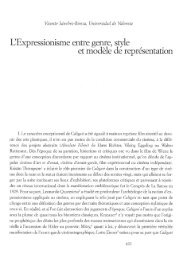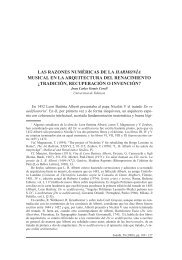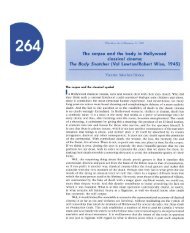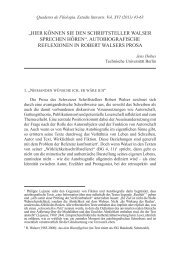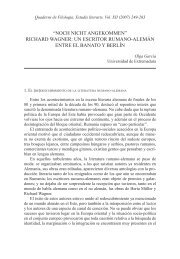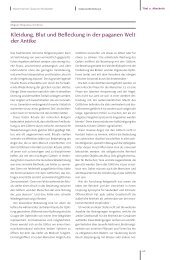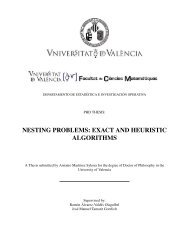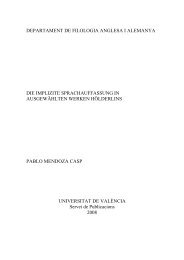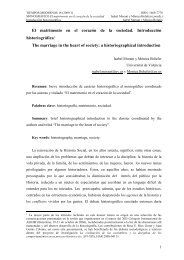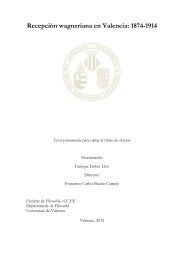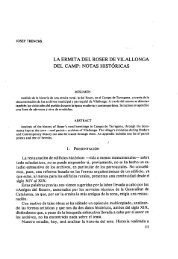- Page 1 and 2: UNIVERSITAT DE VALENCIA FACULTAT DE
- Page 3 and 4: 2.2.- Resolución del problema gene
- Page 5 and 6: 5.3.- El problema de la incertidumb
- Page 7 and 8: En esta Tesis de Licenciatura se ll
- Page 9 and 10: sistemas que se pretende estabiliza
- Page 11 and 12: un proceso de investigación previa
- Page 13 and 14: dinámicos lineales deterministas y
- Page 15 and 16: sensibilidad de los parámetros de
- Page 17 and 18: 1.- EL ANALISIS DINAMICO DE MODELOS
- Page 19 and 20: definiciones dadas por otros autore
- Page 21 and 22: Así pues, es necesario explicar, a
- Page 23 and 24: darse en la selección de las obser
- Page 25 and 26: trate. También, el comportamiento
- Page 27 and 28: ) Por la linealidad de las ecuacion
- Page 29 and 30: una mejor aproximación de la reali
- Page 31 and 32: modelización de sistemas económic
- Page 33 and 34: 1.3.- Estabilidad de sistemas diná
- Page 35: Sea 1.3.1.- Estabilidad en sistemas
- Page 39 and 40: cuya derivada total o diferencial s
- Page 41 and 42: Por tanto, . x = A' x es una primer
- Page 43 and 44: 2.1.- Planteamiento del problema ge
- Page 45 and 46: (Cálculo de Variaciones, Teoría d
- Page 47 and 48: 2.2.- Resolución del problema gene
- Page 49 and 50: x(t) = x * (t) + δx(t) (2.2.3) don
- Page 51 and 52: La solución, x * (t), a esta ecuac
- Page 53 and 54: d . Fx - ─── Fx = Hx + p = 0
- Page 55 and 56: (x0,t0) a (x(T),T), donde estos úl
- Page 57 and 58: como ⌠ T S[x(T),T] − S[x0,0] +
- Page 59 and 60: Quedando 54 . p = - Hx (2.2.29) De
- Page 61 and 62: El vector p, juega el papel que jug
- Page 63 and 64: Despreciando los términos de orden
- Page 65 and 66: 2.3.- Estabilidad y Control óptimo
- Page 67 and 68: 2.4.- Controlabilidad y Observabili
- Page 69 and 70: ┌──────────
- Page 71 and 72: espacio generado por las columnas d
- Page 73 and 74: Sustituyendo en (2.4.8) la expresi
- Page 75 and 76: 3.- CONTROL OPTIMO Y ESTABILIZACION
- Page 77 and 78: una importante clase de control muy
- Page 79 and 80: controlar el sistema que viene dado
- Page 81 and 82: Antes de avanzar en la resolución
- Page 83 and 84: uso de alguna variable uj(t) con un
- Page 85 and 86: epresentarán a la misma forma cuad
- Page 87 and 88:
Otra consideración que debe hacers
- Page 89 and 90:
3.3.- Estabilizabilidad de un siste
- Page 91 and 92:
Si A y M fueran constantes 7 , el s
- Page 93 and 94:
Se supone que dado un estado inicia
- Page 95 and 96:
Las ecuaciones (3.4.5) y (3.4.9) so
- Page 97 and 98:
Como se cumple siempre que existe l
- Page 99 and 100:
todas las matrices A(t), B(t), M(t)
- Page 101 and 102:
normalmente, ecuación de Riccati (
- Page 103 and 104:
siguiente matriz (3.4.35) es defini
- Page 105 and 106:
100 británica se plantea mantener
- Page 107 and 108:
102 pendiente), y una política de
- Page 109 and 110:
. - ß = x(t) , integrando ambos la
- Page 111 and 112:
1 1 ⌠ T J2 = ── [y(T)'S y(T)]
- Page 113 and 114:
108 donde K(t) es una matriz defini
- Page 115 and 116:
3.5.- Modelos de seguimiento lineal
- Page 117 and 118:
112 A lo largo del capítulo 5 se c
- Page 119 and 120:
u * (t) = - M -1 B' p (3.5.8) 114 S
- Page 121 and 122:
116 p(T) = S [x(T) - xˆ (T)] = K(T
- Page 123 and 124:
4.1.-Modelos macroeconómicos tipo
- Page 125 and 126:
correspondiente al sector público,
- Page 127 and 128:
122 lineal con horizonte temporal i
- Page 129 and 130:
g = - p --- m Por (3.4.19), se tien
- Page 131 and 132:
por el C.O., para y(0) = y0 . y * (
- Page 133 and 134:
128 Tras el examen de la Figura 4.1
- Page 135 and 136:
130 En la Figura 4.1.IV, las curvas
- Page 137 and 138:
132 La figura 4.1.VII recoge el esc
- Page 139 and 140:
4.1.1.2.- MODELO B. (PHILLIPS) 134
- Page 141 and 142:
136 La estabilidad del sistema econ
- Page 143 and 144:
138 No basta con variar el gasto p
- Page 145 and 146:
140 siempre que (α - 1 - (ß σ /
- Page 147 and 148:
142 Nótese que estos tres tipos de
- Page 149 and 150:
144 El horizonte temporal se consid
- Page 151 and 152:
146 Analizando cuál sería el gast
- Page 153 and 154:
C A S O 2 148 Si se tomara la ofert
- Page 155 and 156:
150 La trayectoria óptima de la de
- Page 157 and 158:
CUADRO 4.1.II.- RESUMEN MODELO B (P
- Page 159 and 160:
4.1.2.- Una economía abierta. 154
- Page 161 and 162:
siendo ┌─ ─┐ ┌─ ─┐
- Page 163 and 164:
Para los valores de los distintos p
- Page 165 and 166:
160 la evolución temporal óptima
- Page 167 and 168:
162
- Page 169 and 170:
164
- Page 171 and 172:
166 4.2.- Modelo de estabilización
- Page 173 and 174:
168 x(0)= x0 , conocido , estando e
- Page 175 and 176:
óptimo u * (t) , u * (t) = (α(xˆ
- Page 177 and 178:
172 Debido al predominio que ha ten
- Page 179 and 180:
174 - una cantidad de referencia pa
- Page 181 and 182:
176 - Aplicación de un programa de
- Page 183 and 184:
178 Las representaciones matemátic
- Page 185 and 186:
180 elementos de teoría o polític
- Page 187 and 188:
182 En los dos casos que se van a c
- Page 189 and 190:
c) Matriz residual. Da lugar al val
- Page 191 and 192:
-------------------- MODELO 1. ----
- Page 193 and 194:
la inercia productiva en el increme
- Page 195 and 196:
┌─ ─┐ ┌─ ─┐ │α1(
- Page 197 and 198:
192 - ß6 < 0. El signo es negativo
- Page 199 and 200:
control Son sus componentes ┌─
- Page 201 and 202:
196 Como las matrices A, B, C, Q, y
- Page 203 and 204:
198
- Page 205 and 206:
200 Ahora bien, si el vector û (t)
- Page 207 and 208:
202
- Page 209 and 210:
204 la que en verdad se ha venido d
- Page 211 and 212:
206 estabilizar un sistema dinámic
- Page 213 and 214:
5.1.- Supuestos utilizados. 208 El
- Page 215 and 216:
210 5.2.- El problema de los datos:
- Page 217 and 218:
212 conjunto de todos los estados a
- Page 219 and 220:
214 dimensión igual al número de
- Page 221 and 222:
216 La solución al problema aborda
- Page 223 and 224:
Sea sujeto a T-1 J = x T ' S x T +
- Page 225 and 226:
220 cuáles son los valores instant
- Page 227 and 228:
222 5.3.- El problema de la incerti
- Page 229 and 230:
224 que la respuesta dinámica de l
- Page 231 and 232:
de ésta (modelos deterministas, pl
- Page 233 and 234:
228 sido estudiado del LCG, que se
- Page 235 and 236:
en distintos instantes. Vε = E(ε
- Page 237 and 238:
232 proporcionan una mayor informac
- Page 239 and 240:
234 Se puede incluir las variables
- Page 241 and 242:
c) Incertidumbre en la especificaci
- Page 243 and 244:
5.3.2.- Control óptimo de modelos
- Page 245 and 246:
240 con números borrosos triangula
- Page 247 and 248:
242 profundizar en el estudio de pr
- Page 249 and 250:
244 - El vector de los valores dese
- Page 251 and 252:
246 5.4.- El problema de la no line
- Page 253 and 254:
248 de problemas de optimización i
- Page 255 and 256:
250 Optimo Estocástico, que las di
- Page 257 and 258:
252 óptima, (adaptación activa).
- Page 259 and 260:
254 actual del sistema, y por la m
- Page 261 and 262:
- restricciones de igualdad. - rest
- Page 263 and 264:
258 El problema consistiría en tra
- Page 265 and 266:
control y (o) sobre éstas conjunta
- Page 267 and 268:
262 que da lugar a un Hamiltoniano
- Page 269 and 270:
264 ha explicado el proceso real de
- Page 271 and 272:
266 BECKER,R.(1979), las soluciones
- Page 273 and 274:
268 Otra limitación del planteamie
- Page 275 and 276:
270 considerar que la solución obt
- Page 277 and 278:
272 Las conclusiones extraídas se
- Page 279 and 280:
274 fenómenos económicos. La esta
- Page 281 and 282:
276 modelos aleatorios o estocásti
- Page 283 and 284:
278 - El sistema de ecuaciones dife
- Page 285 and 286:
280 - El Problema Lineal Cuadrátic
- Page 287 and 288:
282 Optimo se ha recogido de forma
- Page 289 and 290:
284 nivel económico. Así, no se h
- Page 291 and 292:
7. REFERENCIAS BIBLIOGRAFICAS. 286
- Page 293 and 294:
288 CHIARELLA, Carl (1985). - " Ana
- Page 295 and 296:
290 KENDRICK, D. (1979). - " Adapta
- Page 297 and 298:
292 PITCHFORD, J.; TURNOVSKI, S.(19
- Page 299:
294 WILAYES, D. y MALVACHE, N. (198



